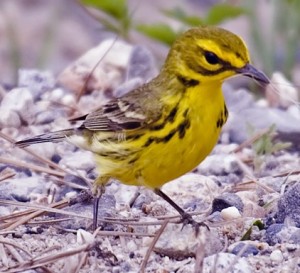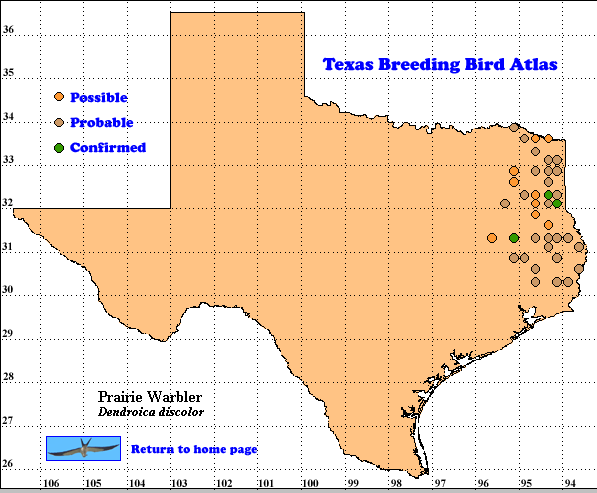The name “Prairie Warbler” is misleading and inaccurate, suggesting the species is a bird of open, seemingly endless grasslands, broken only by riparian corridors along flowing streams. However, neither of the two well- defined subspecies fit this picture. The most widespread, migratory race breeds in old fields in the process of reverting to forest and similar habitats or breeds at woodland edges. A second form is resident in mangroves along the coast of south Florida (Pyle 1997, Nolan et al. 1999).
DISTRIBUTION. During the 1987-1992 field work seasons of the TBBA project, volunteers found breeding evidence scattered through the Pineywoods region (see the region map in Lockwood and Freeman [2004]). This range adjoins southeast Oklahoma where atlasers reports breeding for this species (Bay 2004) and the North American Breeding Bird Survey (BBS) reports a relative abundance of 3-10 Prairie Warblers per 40 km (25 mi) route, much higher than the figure for Texas (Sauer et al. 2005).
Elsewhere in North America this species breeds from Missouri to southern Maine and south to the Gulf Coast with highest relative abundances in eastern Virginia and North Carolina. This warbler is resident (non- migratory) in Florida, the West Indies and the shores of Quintana Roo (Mexico), Belize, Guatemala and Honduras (Howell and Webb 1995, Nolan et al. 1999, Sauer et al. 2005).
SEASONAL OCCURRENCE. Most migrant Prairie Warblers arrive in Texas from mid-April to early May. Breeding probably occurs from late May to late July. In Oklahoma breeding is reported in the southeast corner from May to July (Bay 2004). Southbound migration takes place primarily from early August to late September with laggards present as late as November (Oberholser 1974, Lockwood and Freeman 2004).
BREEDING HABITAT. Prairie Warblers breed in Texas in disturbed situations reverting to woodland with young trees and bushes and open areas and also at shrubby woodland edges. They are not found in areas with closed canopies or where trees are higher than about 14 m (45 ft; Oberholser 1974, Nolan et al. 1999).
The female builds the nest in bushes, brier tangles, saplings or low tree limbs, usually 0.3-3 m (1-10 ft) above ground. She brings insect or spider webs and forms a network attached to supporting plants. To this she sticks plant fibers to start the shell. More insect silk is added as the shell is filled with materials such as bark shreds, and grasses. She shapes the nest with her body and feet and lines it with grasses, feather and hair (Harrison 1979, Nolan et al. 1999).
In the resulting compact cup, the female usually lays 4 (range 3-5) very pale cinnamon or gray eggs, spotted or dotted with browns or grays. Incubation lasts 12 days and young leave the nest 8-11 days after hatching and are independent at 34-55 days after hatching. Most Prairie Warbler pairs raise one brood per season. About 1/4 of nests are parasitized by Brown- headed Cowbirds (Molothrus ater; Harrison 1979, Nolan et al. 1999).
STATUS. Prairie Warblers are rare to uncommon summer residents of the eastern quarter of Texas (Lockwood and Freeman 2004). This range seems unchanged in recent years; the distribution of breeding records on the TBBA map is similar to the area covered by nesting spots on Oberholser’s 1974 map. Relative abundance data from 12 BBS routes in east Texas, <1 Prairie Warbler per route per year, are consistent with Lockwood and Freeman’s (2004) abundance estimate. The BBS population change estimate of -2.6% per year for the period 1980-2005, although not too different from the statistically significant continental trend of -1.4% (Sauer et al. 2005) is not encouraging. Since the preferred breeding habitat of this species requires active management and the population is sparse, preservation of Prairie Warbler as a breeding species in Texas will require continuing work to maintain its ephemeral habitat. Text by Robert C. Tweit (2007)
Harrison, H. H. 1979. A field guide to western birds’ nests. Houghton Mifflin, Boston, MA.
Oberholser, H. C. 1974. The bird life of Texas. University of Texas Press, Austin.

